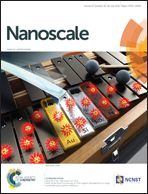Hierarchical bioceramic scaffolds with 3D-plotted macropores and mussel-inspired surface nanolayers for stimulating osteogenesis†
Abstract
The hierarchical structure of biomaterials plays an important role in the process of tissue reconstruction and regeneration. 3D-plotted scaffolds have been widely used for bone tissue engineering due to their controlled macropore structure and mechanical properties. However, the lack of micro- or nano-structures on the strut surface of 3D-plotted scaffolds, especially for bioceramic scaffolds, limits their biological activity. Inspired by the adhesive versatility of mussels and the active ion-chelating capacity of polydopamine, we set out to prepare a hierarchical bioceramic scaffold with controlled macropores and mussel-inspired surface nanolayers by combining the 3D-plotting technique with the polydopamine/apatite hybrid strategy in order to synergistically accelerate the osteogenesis and angiogenesis. β-Tricalcium phosphate (TCP) scaffolds were firstly 3D-plotted and then treated in dopamine–Tris/HCl and dopamine–SBF solutions to obtain TCP-DOPA-Tris and TCP-DOPA-SBF scaffolds, respectively. It was found that polydopamine/apatite hybrid nanolayers were formed on the surface of both TCP-DOPA-Tris and TCP-DOPA-SBF scaffolds and TCP-DOPA-SBF scaffolds induced apatite mineralization for the second time during the cell culture. As compared to TCP scaffolds, both TCP-DOPA-Tris and TCP-DOPA-SBF scaffolds significantly promoted the osteogenesis of bone marrow stromal cells (BMSCs) as well as the angiogenesis of human umbilical vein endothelial cells (HUVECs), and the TCP-DOPA-SBF group presented the highest in vitro osteogenic/angiogenic activity among the three groups. Furthermore, both TCP-DOPA-Tris and TCP-DOPA-SBF scaffolds significantly improved the formation of new bone in vivo as compared to TCP scaffolds without a nanostructured surface. Our results suggest that the utilization of a mussel-inspired Ca, P-chelated polydopamine nanolayer on 3D-plotted bioceramic scaffolds is a viable and effective strategy to construct a hierarchical structure for synergistically accelerating osteogenesis.


 Please wait while we load your content...
Please wait while we load your content...